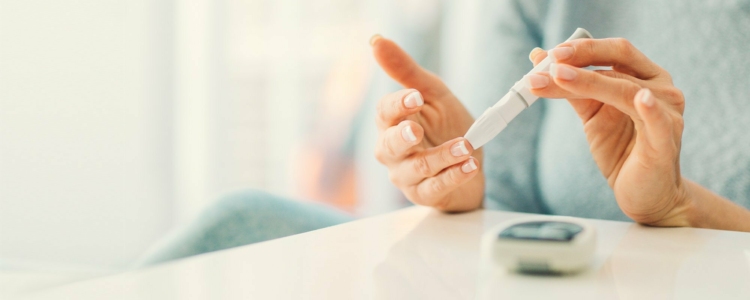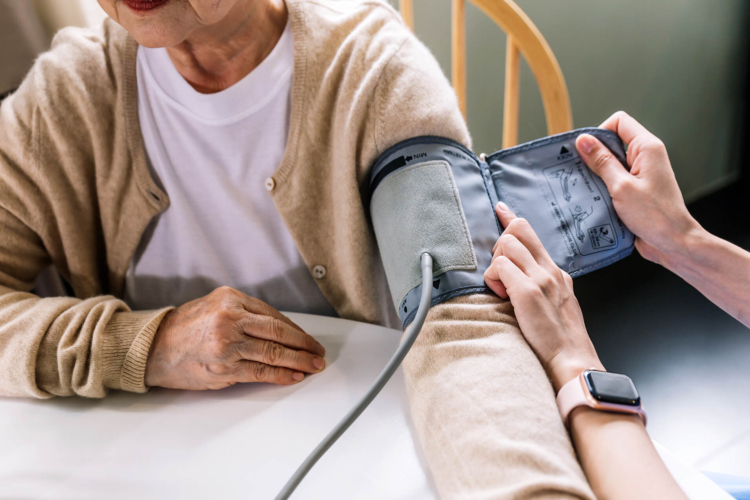There are different types of diabetes (type 1, type 2, prediabetes, gestational diabetes, etc.) that impact people’s lives in different ways. But these different types of diabetes all have one thing in common: they cause high blood sugar.
What is diabetes?
Diabetes is the result of a lack or inadequate use of insulin, a hormone produced by the pancreas that regulates blood sugar levels.
When your body does not use insulin correctly, your tissue, muscle, heart and brain cells are unable to absorb glucose (sugar contained in food) and convert it into energy. So, glucose accumulates in your bloodstream, which results in hyperglycemia.
Elevated blood sugar levels can eventually lead to organ and blood vessel complications, because fat cells build up on blood vessel walls, narrowing vessels and reducing blood flow. These deposits can eventually lead to heart disease.
There are 880,000 people in Quebec who have diabetes, and 250,000 of them do not know they have the disease.
Type 1 diabetes
Once known as juvenile diabetes, type 1 diabetes is an autoimmune disease that usually develops at an early age (under 30), characterized by an almost complete absence of insulin production. So, the survival of people with type 1 diabetes depends entirely on insulin therapy, such as daily insulin injections or insulin pump therapy. 5 to 10% of diabetics have type 1 diabetes and it currently cannot be prevented or cured.
Causes / risk factors
The cause of this type of diabetes is still unknown. The immune system of people with type 1 diabetes destroys the pancreas’ insulin-producing beta cells, but researchers have not yet found the exact cause of this autoimmune response. However, there is reason to believe that a genetic predisposition and certain environmental factors could play a significant role in the development of the disease.
Symptoms
The three most common symptoms of hyperglycemia are excessive thirst, weight loss and urination. But in the long term, elevated blood sugar can lead to eye, kidney, heart, nerve and blood vessel complications. A blood test can confirm if these symptoms are caused by hyperglycemia.
To learn more about early warning signs of the disease, please read our full article on diabetes symptoms.
Type 2 diabetes
This is the most common type of diabetes, accounting for 85% to 90% of cases, and it occurs mostly in people aged 40 and older. If you have type 2 diabetes, your body does not make enough insulin or is not using insulin properly, or your cells are not responding well to insulin (insulin resistance). In any case, people with type 2 diabetes have an abnormally high level of glucose in their blood.
Although type 2 diabetes mainly affects adults, the rate of children and adolescents diagnosed with the disease has been climbing over the last few years. The leading cause of type 2 diabetes in young people is excess body weight, and certain ethnic minority groups are at a greater risk, such as people of Indigenous, African, Arab, Asian and Latin American descent.
Causes / risk factors
There are many factors that may increase your risk of type 2 diabetes, and a combination of factors may contribute to the development of the disease. Here are the most common ones:
- Being overweight (this is the main risk factor, especially abdominal fat);
- Low level of physical activity;
- Poor eating habits;
- Sex (men are at a higher risk);
- Age (the risk increases as you get older);
- High blood pressure;
- Family history;
- Ethnicity (people of Indigenous, African, Arab, Asian and Latin American descent are at a higher risk).
Symptoms
The three most common symptoms of hyperglycemia are excessive urination, thirst, and weight loss. But these symptoms are not always obvious, which explains why type 2 diabetes can go unnoticed for months or even years before being diagnosed. Thankfully, you can regulate your blood sugar and control the disease by eating well, exercising, managing your stress and taking your medication. This is why it is important to carefully monitor your blood sugar levels; your pharmacist affiliated with Accès pharma can help you with this.
To learn more about early signs of the disease, please read our full article on diabetes symptoms.
Prediabetes
Although it is estimated that prediabetes affects 1 in 5 Quebeckers, many of them do not know that they have the condition. Prediabetes (also known as ‘impaired glucose tolerance’ or ‘impaired fasting glucose’) is characterized by a higher than normal blood glucose level that is still lower than the level used to diagnose diabetes. It may mean that you are predisposed to developing type 2 diabetes. In fact, nearly half of people who have prediabetes will eventually go on to develop diabetes if they do not act fast. Because, if you eat well, get more exercise, lose weight and quit smoking, you can prevent or at least delay diabetes.
Causes / risk factors
A family history of diabetes and abdominal obesity are two of the many risk factors for prediabetes.
Symptoms
Prediabetes rarely produces clear symptoms, but it can be identified with a blood test at your next checkup. Talk to your doctor!
Gestational diabetes
Gestational diabetes is caused by hormones released by the placenta that make cells less responsive to insulin (insulin resistance). In some women, the pancreas does not produce enough insulin to counteract the effect of the hormones, which leads to hyperglycemia and diabetes. 3 to 20% of pregnant women see a rise in blood glucose levels towards the end of their second trimester. Although the disease goes away after childbirth 90% of the time, the mother is at a higher risk of developing type 2 diabetes later in life.
Risk factors
Usually, women who are at a higher risk of developing gestational diabetes:
- Are more than 35 years old
- Are overweight
- Have family members with type 2 diabetes
- Are pregnant with more than one baby
- Have previously delivered a baby weighing more than 4 kg (9 lb)
- Have previously had gestational diabetes
- Are part of an ethnic minority group with an increased risk for diabetes (people of Indigenous, Latin American, Asian, Arab or African descent)
- Have previously had higher than normal blood sugar levels (prediabetes)
- Take medication containing cortisone regularly
- Have polycystic ovary syndrome
Fortunately, gestational diabetes does not increase the risk of birth defects or the chances that the baby will be born with diabetes.
However, there still can be complications for the baby, such as above-average weight (more than 4 kg or 9 lb) or low blood sugar (hypo glycemia) at birth. But you can considerably reduce the risk of complications with careful management. Your pharmacist affiliated with Accès pharma can help you monitor and control your gestational diabetes.
Symptoms
Signs of gestational diabetes are hard to identify, because they are often the same as common pregnancy symptoms, such as fatigue, thirst, more frequent urination and headaches.
Other types
Here are some less common types of diabetes:
- Secondary diabetes that results from another medical condition (pancreatic diseases, endocrine diseases, genetic diseases, viral infections)
- Secondary diabetes that results from taking medication (glucocorticoids, anti-cancer or anti-epileptic drugs, medication to treat hypertension, hyperthyroidism, hypercholesterolemia or some mental health disorders)
- MODY diabetes (maturity-onset diabetes of the young)
- LADA diabetes (latent autoimmune diabetes in adults)
Conclusion
Please note that you can take a blood glucose test at the pharmacy to find out your blood sugar level. But only blood tests that are sent to a laboratory can give you an accurate and reliable diagnosis.
If you think that you have diabetes symptoms, talk to your pharmacist affiliated with Accès pharma or a health professional.
This information is not a substitute for professional medical advice and pharmacist-owners affiliated with Accès pharma cannot be held responsible for this information. The information was true and accurate at the time of publication, but it is subject to change.






